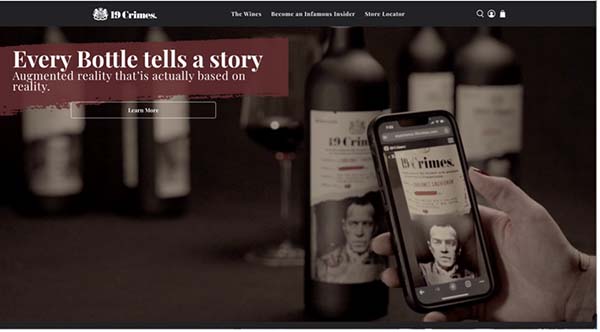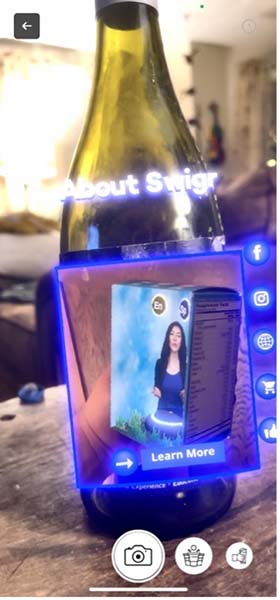According to research by Artillery Intelligence, 32% of U.S. adults now actively use augmented reality (and 46% of those say they engage with AR at least weekly). So AR is a technology printers and their customers can no longer ignore. While most of this AR use is for gaming or social media (such as Snapchat filters), AR is making its way into product packaging, advertising, and e-commerce.
There are two types of AR we see most commonly in the marketing space—web- (or browser-) based AR (WebAR) and app-based AR, primarily using image recognition (IR). While there are other types of AR, such as filters that allow you to place glasses on your face or visualize a new piece of furniture in your living room, these are the two most used on posters, direct mail, product packaging, and other marketing pieces.
What’s the difference between the two? If you’re looking to add AR to your marketing arsenal, is one better than another?
App-based AR has been around longer than WebAR and offers a high level of flexibility to do pretty much anything the marketer wants it to do. This is the technology behind the famous and long-running 19 Crimes Wines labels, for example. With these labels, shoppers scan a QR code on the label and the faces on the wine labels come alive, telling the stories of the crimes that sent them into exile in Australia in the days of old. Augmented reality is used to turn photographs of real people into “living,” speaking images that tell you a story.

To create these experiences, 19 Crimes partnered with the immersive experience experts at Tactic Studio and the creative agency Wunderman Thompson. The AR application uses the Vuforia Engine, which specializes in creating photorealistic augmented reality experiences. While most marketers will not replicate AR at this level, the potential for its selling power is undeniable. Fueled by the publicity of multiple awards and powerful word of mouth, in the first two years of the campaign’s inception (2017–2019), sales increased by 40%.
The challenge with such AR experiences, however, is that they are app-based. In the case of 19 Crimes Wines, shoppers must download its Living Wine Labels app (although the app has been downloaded 5.5 million times and the experiences viewed over 22 million times). That’s why, when 19 Crimes Wines partnered with Snoop Dogg to launch its new wine, Snoop Cali Red, it partnered with 8th Wall to create an “Ask the Doggfather” WebAR experience that works on any smartphone without an app and instead has the user scan a QR code.

Scan the code yourself and you’ll immediately notice a difference between the WebAR and the app-based experiences. Snoop Dogg appears in front of you, reciting and acting out lines performed in front of a green screen, uploaded as a video and then viewed through the screen on your mobile phone.
If this description sounds familiar, it’s because 8th Wall is the technology powering RealityBLU’s WebAR platform, which WhatTheyThink has covered extensively. RealityBLU’s holotwins are essentially video “holographic twins” (like 19 Crimes Wines’ Snoop Dogg experience) anchored to a specific location you choose. RealityBLU also offers WebAR-based experiences for 360-degree immersive tours (portals) and 3D objects you can place and explore in your environment (such as a bottle of perfume, a car or a pair of shoes). RealityBLU now offers WebAR games, as well, with all experiences accessible by scanning a QR code. No apps necessary.

(See RealityBLU holotwins in action in a campaign from Texas Tech featuring Coach Jerry McGuire, which had a 13% scan-through rate.)
Interactivity with WebAR experiences is generally through buttons that can lead to websites, e-commerce pages, contact information, and more.
WebAR experiences may be highly accessible, but they do have constraints in terms of complex interactions and functionalities compared to app-based AR. Indeed, while there is a significant appeal of the “no app necessary” approach, app-based applications have a different look and feel that are highly marketable. Platforms like Immersia (with its Swigr app) require users to download the app, but then offer much flexibility in what that experience is. These apps typically use image recognition (IR) technology, so the software is recognizing the design on a label or product packaging, for example.

As long as that image is in view, these platforms offer a wide range of experiences, from embedded videos to flying objects.
AR objects are interactive, allowing the user to dive into a variety of experiences all within the app. Because these experiences are image-based, it also keeps the shopper engaged with the product as long as he or she is engaging with the AR experience. Move the camera away from the product and the experience disappears.
Thus, two different types of AR for two different types of experiences. WebAR has somewhat less flexibility, but is accessible by anyone with a cellphone. IR experiences can have more pizzazz, offer more creativity, but require an app—something not every shopper is willing to download, especially for an individual, first-time experience.

Whether your applications lean toward WebAR or app-based AR, the good news is that more and more platforms are offering simplified and template-based development, making it easy to experiment with both. More and more app-based platforms are moving to WebAR as well, creating more options than ever before. BlippAR is among those now offering WebAR experiences, including fully immersive experiences and those fun flying objects characteristic of app-based platforms. Check out its M&M Music Lounge or the interactive Walk of Fame tour of the legacy of David Bowie.
So get out there, explore and get creative. AR may not be for you or your clients, but then again…maybe it is.










Discussion
Join the discussion Sign In or Become a Member, doing so is simple and free